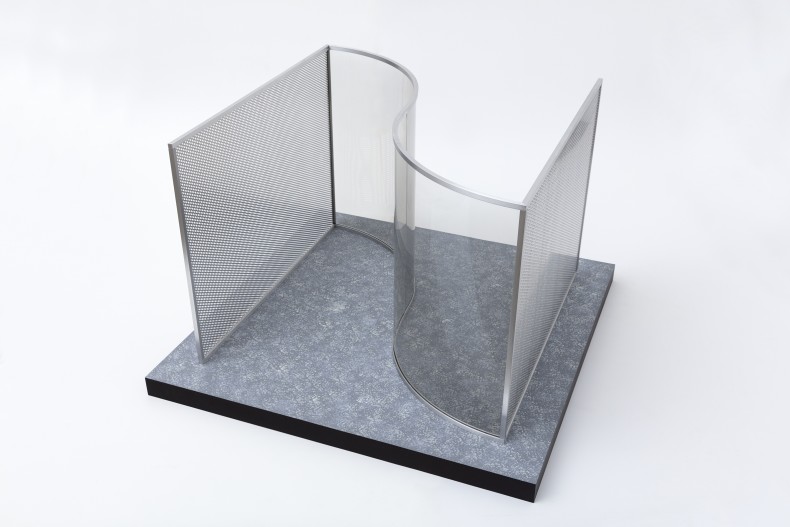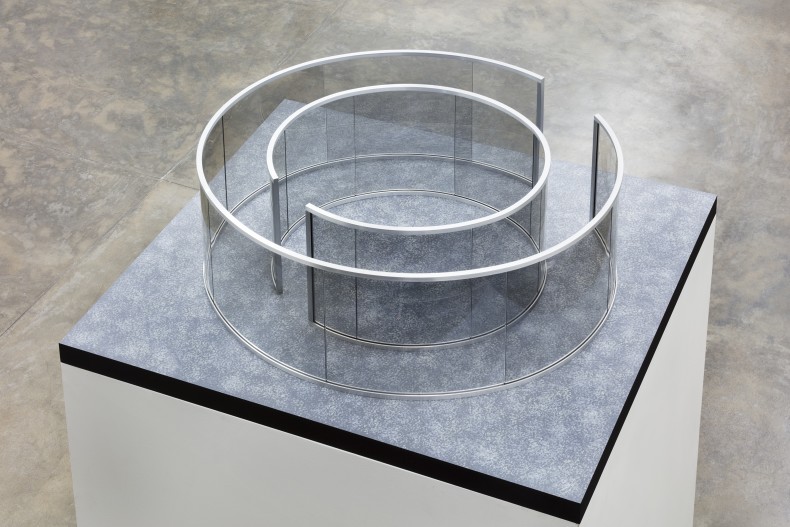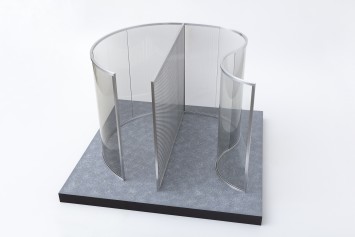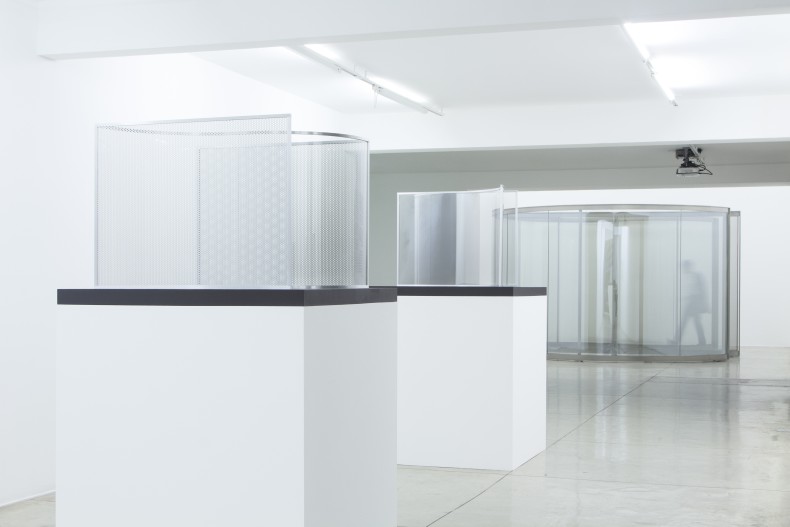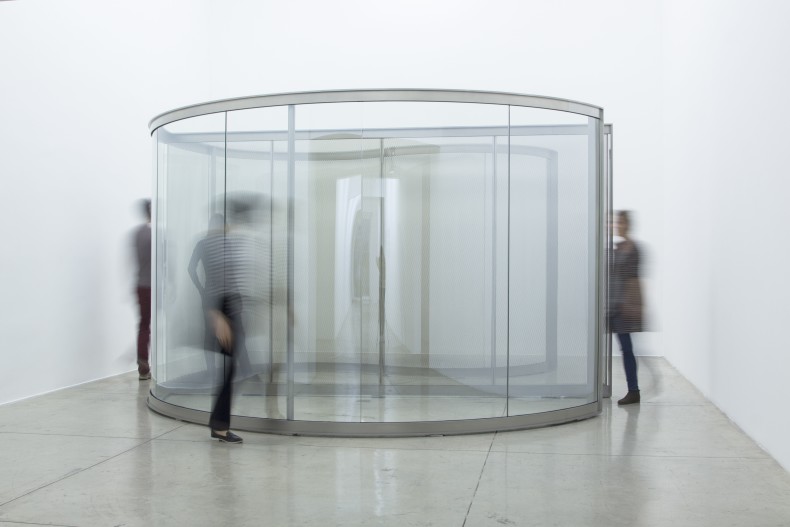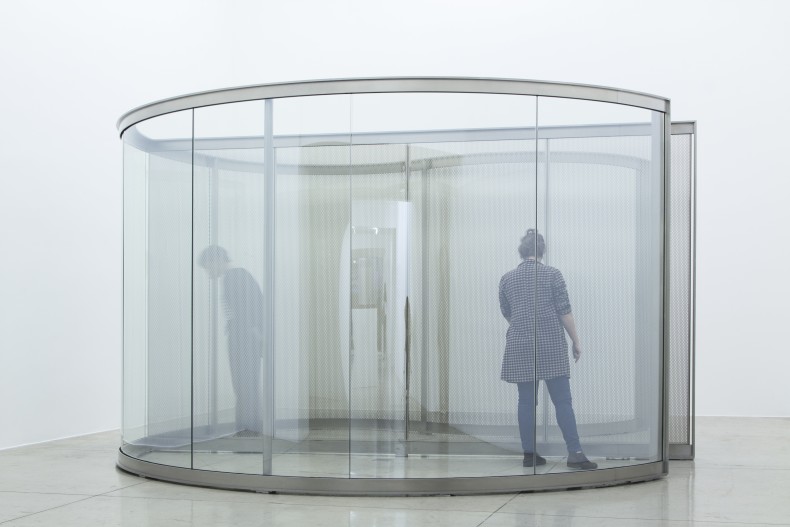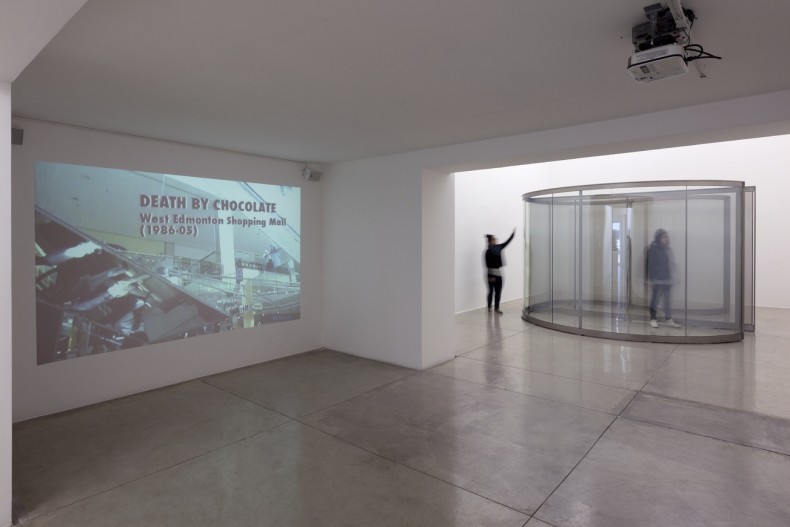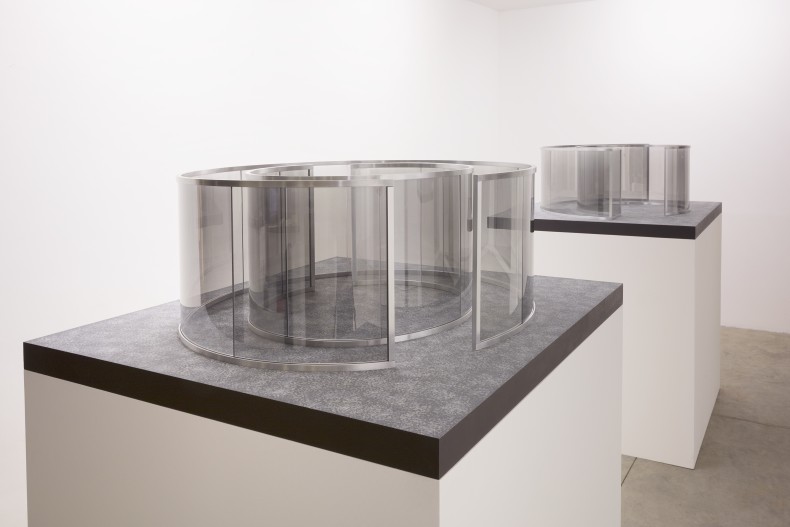|
Just as art is internalized within society, the architecture that displays it is defined by the needs of society at large, and by art as an institutional need. Art as an institution produces ideological meanings and positions that regulate and contain the subjective experience of people placed inside its boundaries. — Dan Graham, “Art in Relation to Architecture / Architecture in Relation to Art,” Artforum, 1979
Galeria Nara Roesler | São Paulo is pleased to present a solo exhibition of Dan Graham’s works (b. Urbana, IL, USA, 1942), on view August 12 through November 4, 2017. The first exhibition of Graham’s work at Galeria Nara Roesler features Pavilion (2016), a new work created specifically for the occasion, in addition to six untitled maquettes (2011–2016) and the video work Death by Chocolate: West Edmonton Shopping Mall (1986–2005). Parallel to the exhibition, the Museum of Image and Sound will screen two of the artist’s emblematic video works: Rock My Religion (1982–1984) and Don’t Trust Anyone Over 30 (2004). Presented in collaboration with Galeria Nara Roesler, the screenings will take place at the museum on Sunday, August 13, at 4pm, followed by a roundtable with Marta Bogéa, Agnldo Farias and Solange Farkas, who will engage in a discussion about Graham’s works, also at the Museum.
Exhibited across the globe, Dan Graham’s pavilions are emblematic of his critical engagement with the visual and cognitive parameters of architectural language within and outside of art institutions. This exhibition provides insight into the oeuvre of an artist who has, since the 1960s, engaged in multimedia experiments in performance, video, and architecture as means to reflect not only on the art institution and its commercial context, but also on the social implication of structures of consumption, representation, and communication.
Emerging in the New York art scene in the 1960s, Graham detected in the approach of Minimal artists a similarity with Functionalism in architecture, insofar as both believed in “objective” form and, as the artist wrote in the essay “Art in Relation to Architecture / Architecture in Relation to Art,” “denied the connotative, social meaning and the context of other, surrounding art or architecture.” Since 1976, Graham has been producing glass and mirror pavilions, which bridge the gap between the objective materiality of art and its connotative significance. As described by the artist, “a first effect for the spectator might be to see the structure and materials in purely aesthetic terms; after a time in the space … the psychological and social aspects of the materials and structure would become evident.” Graham creates a subjective experience for the viewer, who is led to participate in a game of psychological exclusion and inclusion wherein he does not observe artworks or commodities, but instead is himself an object of the gaze. The use of glass and mirrors to modify the experience of viewers finds a corollary in public spaces such as those found in international airports and maternity wards, where these materials are used as partitions and delimitations. As the artist points out, “within the art context it is often only the aesthetic effects of glass and mirror which are noticed, whereas outside the exhibition frame, these same materials are employed to control a person or a group’s social reality.”
A prolific writer, Graham has often focused on issues such as class, gender, popular culture, and social history in his texts. In fact, curator Bennett Simpson believes that Rock My Religion (1982–1984), along with the artist’s writings about the “ideological ramifications of punk music,” positioned Graham as a precursor to what in academic circles was becoming known as ‘cultural studies.’ A documentary collage of music, texts, and film footage, Rock my Religion contrasts the history of religious groups in the United States with the development of rock ’n’ roll. The piece creates a cultural genealogy that begins with the Shakers, an early religious group that promoted celibacy and labor, convening once a week to perform religious rituals in which worshipers rocked and reeled into a hypnotic state. The connection between the rock movement and the Shakers goes beyond the mutual incorporation of trances into their practices. Graham writes, “In the 1950s a new class emerged, a generation whose task was not to produce but to consume; this was the ‘teenager.’ Freed from the work ethic so as not to add to postwar unemployment and liberated from the Puritan work ethic, their philosophy was fun. Their religion was rock ’n’ roll. Rock turned the values of traditional American religion on their head.” Rock My Religion highlights the emergence of Rock culture as a signpost for the development of a market-driven teenage culture that emerged in the postwar context.
Don’t Trust Anyone Over 30 (2004) shares with Rock My Religion the capacity to pierce the American dream in its consideration of an individualistic youth-culture, which conspires with mainstream media and delights in a market of mass consumption. Conceived as a live puppet show and written by Graham, the work was enacted in collaboration with puppet master Phillip Huber and set designer Laurent Bergen, with live music by Japanther, theme by Rodney Graham, and video projections by Tony Oursler. The multimedia work depicts the story of Neil Sky, the youngest-ever President of the United States, who rises to power by dosing Congress with LSD and lowering the voting age to 14. Sky’s platform consists of free dope, free love, and re-education of everyone over 30 through imprisonment in concentration camps. The multimedia theatrical setup that Graham employs to convey the narrative indicates the artist’s interest in systems of communication and rituals of gathering as sociopolitical instruments. Similar to Graham’s pavilions, the Brechtian Gesamtkunstwerk deconstructs the entertainment aspect of the media forms employed, while considering theater symbolically as a vehicle that at once restricts and releases the partition between audience and art.
|
A semiotic analysis often underlies Dan Graham’s work, which approaches symbols and their interpretation in contemporary society. Death by Chocolate: West Edmonton Shopping Mall (1986–2005), produced by Graham at the Banff Centre, Canada, captures humdrum activity at the West Edmonton Mall spanning almost 20 years. The eight-minute compilation shows a synthetic grass garden, domesticated jaguar cubs, an ornamental fountain within a food court, and pools crowded with children. The short video, whose title refers to a store in the mall, draws attention to the plethora of symbols of consumption, leisure, and entertainment placed within the mall’s built landscape, which is largely composed of glass and mirrored walls, surfaces and enclosures. The work embodies Graham’s texts on public spaces in its critique of a capitalist commercial ecosystem created through the visual and structural language of the shopping mall, a corporate capitalist structure. Death by Chocolate: West Edmonton Shopping Mall (1986-2005) touches on the question that, according to Graham, is implicit in every architectural work: “What is art and architecture’s relation to and sociopolitical effect on their immediate environment?”

